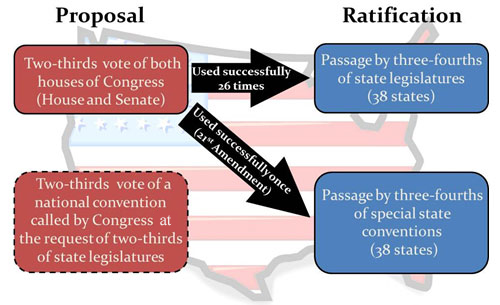
Amending the Constitution is a difficult process and requires the approval of many people from across the country. The Framers explained the procedure in Article V, the fifth section, of the Constitution. Interactive popup. Assistance may be required.
The Congress, whenever two thirds of both Houses shall deem it necessary, shall propose Amendments to this Constitution, or, on the Application of the Legislatures of two thirds of the several States, shall call a Convention for proposing Amendments, which, in either Case, shall be valid to all Intents and Purposes, as Part of this Constitution, when ratified by the Legislatures of three fourths of the several States or by Conventions in three fourths thereof, as the one or the other Mode of Ratification may be proposed by the Congress.
While the language of Article V may be confusing, the formula is actually quite straightforward. There are two steps to becoming part of the Constitution: the proposal step and the ratification step.
Proposal
The proposal of an amendment requires approval of a two-thirds vote of each branch of Congress. All successful constitutional amendments have taken this route to proposal. An amendment can also be proposed by a two-thirds vote at a national convention called by Congress at the request of two-thirds of state legislatures. This more complicated process has never been used.
Ratification
Ratification of an amendment requires approval of at least three-fourths of all state legislatures. With 50 states in the Union, this means that 38 states must approve the amendment. All successful amendments except one have taken this path to ratification. Ratification of an amendment requires approval of at least three-fourths of special state conventions. Only the 21st amendment, the repeal of Prohibition, has taken this path.
Note well who does not have a formal role in this process: the President and the Supreme Court. Amendments involve the Congress and the states only. The president does not get to sign or veto an amendment like he or she can a law. The Supreme Court cannot declare an amendment unconstitutional.
The following graphic summarizes the process:

→ Quick Reflection:
What is so hard about the amendment process? Interactive popup. Assistance may be required.
The Constitution requires many people to vote for an amendment. First, it requires a two-thirds vote in both the House of Representatives and the Senate. This means that many members of both political parties, Republicans and Democrats, will probably have to agree on it. Then, the amendment goes to the states, where three-fourths of the states need to agree. That means 38 states from all over the country have to approve it. 
The Framers made the Constitution difficult to amend on purpose. Take another look at the first sentence of Article V above. You will see that the document is to be amended when "necessary." They did not want people changing the highest law in the land on a whim. For most issues, a regular law will do.
The next section will examine just what types of issues have risen to the level of "necessary" to go into the Constitution.